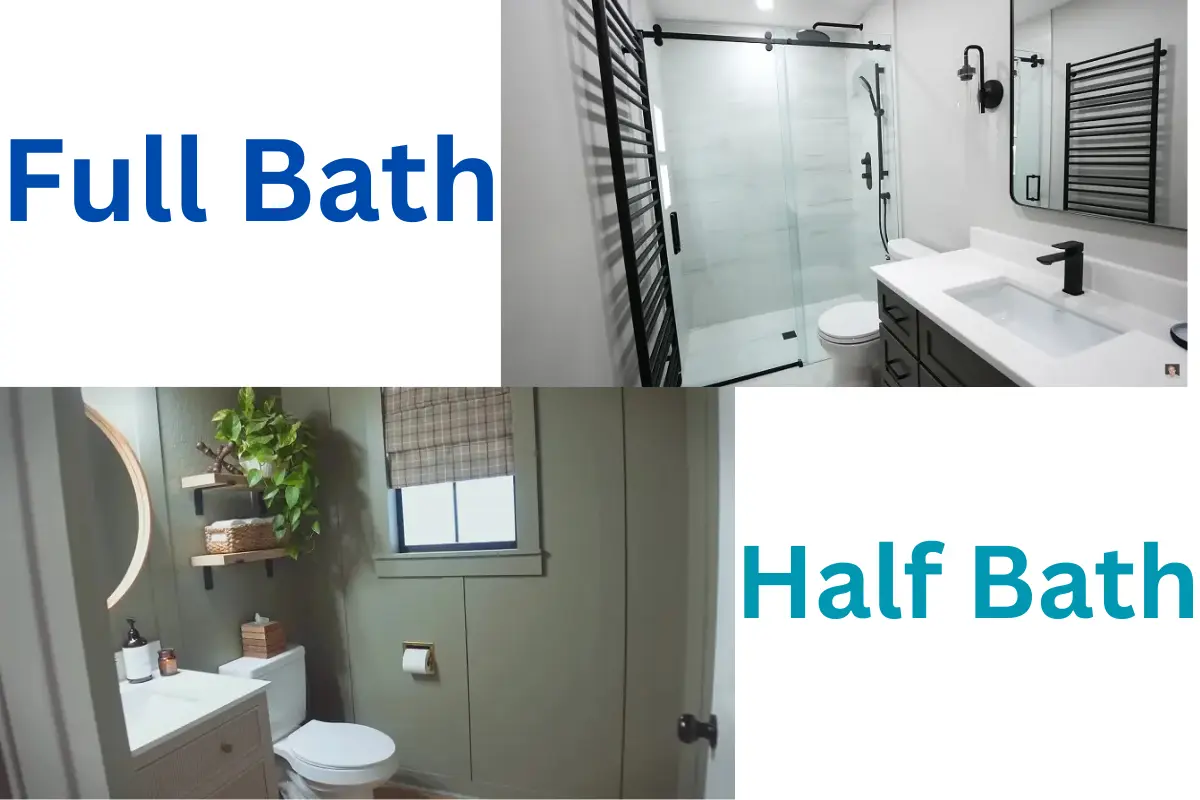Deciding between a full bath vs half bath can be tricky. Both options have their pros and cons.
Choosing the right type of bathroom for your home depends on your needs and lifestyle. A full bath includes a sink, toilet, and bathing area like a shower or tub. It’s ideal for families or anyone who enjoys a long soak.
On the other hand, a half bath, or powder room, usually only has a sink and a toilet. This option is perfect for guests and can save space. Understanding the differences can help you make the best choice for your home. Whether you’re renovating or building new, knowing what each type offers will guide your decision. Let’s dive into the details to help you choose wisely.
Full Bath Essentials
Understanding the difference between a full bath and a half bath is important. It helps in home planning and renovation projects. A full bath offers more amenities and space. Here, we’ll discuss the essentials of a full bath.
Components Of A Full Bath
A full bath includes all essential elements for a complete bathing experience. Here are the main components:
- Shower or Bathtub: A full bath must have either a shower, a bathtub, or both.
- Sink: Every full bath has at least one sink.
- Toilet: A toilet is a must in a full bath.
Each of these components plays a crucial role. They ensure the convenience and functionality of the bathroom. Sometimes, a full bath might also include extra features. Such as:
- Bidet: An additional hygiene feature.
- Vanity: Provides storage and a mirror.
All these components together make a full bath a complete and comfortable space.
Common Features
Full baths share many common features. These elements enhance the user experience and make the bathroom more functional. Here are some of the most common features found in full baths:
- Storage Space: Cabinets and shelves for storing toiletries and towels.
- Lighting: Adequate lighting is essential for visibility and ambiance.
- Ventilation: Proper ventilation to avoid moisture build-up and mold.
These features ensure a pleasant and practical environment. A well-designed full bath is not just about the basic components. It’s also about the additional features that enhance comfort and usability.
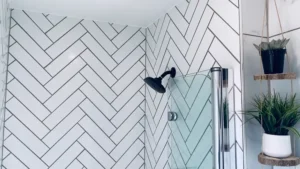
Half Bath Basics
Choosing between a full bath and a half bath depends on your needs. A half bath, also known as a powder room or guest bath, is a bathroom that contains only a toilet and a sink. It’s smaller and usually located near common areas. This makes it convenient for guests. Let’s dive into the basics and typical uses of a half bath.
Components Of A Half Bath
A half bath typically includes two main components:
- Toilet: This is the most essential part. It’s where users go to relieve themselves.
- Sink: This is used for washing hands. It usually comes with a mirror above it.
These components make a half bath a simple and functional space. Sometimes, a half bath might also have some additional features:
| Feature | Description |
|---|---|
| Mirror | Placed above the sink for convenience. |
| Storage | Small cabinets or shelves for toiletries. |
| Decor | Wall art or simple decorations to enhance the look. |
In summary, a half bath is a compact space. It has the essentials for quick use. This keeps it simple and easy to maintain.
Typical Uses
A half bath serves several purposes:
- Guest Convenience: A half bath is often used by guests. It’s usually located near the living room or dining area.
- Quick Access: It’s perfect for quick use. No need to go to the main bathroom.
- Space Saving: It takes up less space. Ideal for smaller homes or apartments.
Many homeowners add a half bath to increase their home’s value. It’s a desirable feature for buyers. Half baths are also great for families with multiple members. They help reduce waiting times for the main bathroom.
In conclusion, a half bath is practical and versatile. It’s a valuable addition to any home. It provides convenience without taking up much space.
Size Differences
Choosing between a full bath and a half bath can be confusing. Understanding the size differences can help make the decision easier. Full baths and half baths serve different purposes. They also differ in size and features. Here, we will explore these differences to help you decide what suits your needs best.
Dimensions Of Full Baths
A full bath includes a toilet, sink, and a bathtub or shower. The average size is usually between 40 to 45 square feet. Some full baths can be larger, especially in master bedrooms.
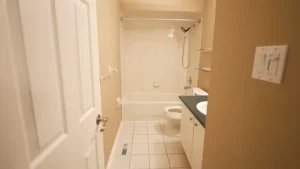
The dimensions can vary based on the layout. Here are some common measurements:
- Standard Full Bath: 5 feet by 8 feet
- Master Full Bath: 10 feet by 12 feet
- Compact Full Bath: 5 feet by 7 feet
Full baths are ideal for families. They provide enough space for multiple users. They also offer more storage options. Having a full bath can increase the value of your home.
Dimensions Of Half Baths
A half bath, or powder room, includes only a toilet and sink. These baths are smaller, usually around 15 to 20 square feet. They are commonly found on the main floor of homes for guest use.
Here are some typical dimensions:
- Standard Half Bath: 3 feet by 6 feet
- Compact Half Bath: 3 feet by 5 feet
- Larger Half Bath: 4 feet by 6 feet
Half baths are convenient and save space. They are easier to clean and maintain. While they add less value than full baths, they still enhance home functionality. They are great for guests, reducing foot traffic in private areas.

Design Considerations
Choosing between a full bath and half bath can be challenging. Each type of bathroom has its own benefits and design considerations. A full bath typically includes a toilet, sink, shower, and bathtub. A half bath, often called a powder room, usually contains only a toilet and sink. Knowing the differences can help you decide which is best for your home.
Styling A Full Bath
Styling a full bath offers many options. A full bath is larger, so you have more space to work with. This allows for a variety of design elements and storage solutions.
Key elements to consider:
- Color scheme: Light colors make the space feel bigger. Dark colors add luxury.
- Fixtures: Choose modern or classic styles. Ensure they match your overall design.
- Storage: Use cabinets, shelves, and baskets. Keep your space organized and tidy.
- Lighting: Use a mix of overhead and task lighting. This ensures the space is bright and functional.
- Accessories: Add mirrors, artwork, and plants. These add character and warmth to the room.
A well-designed full bath is both functional and beautiful. Use the space wisely and add your personal touch.
Styling A Half Bath
Styling a half bath can be fun and creative. This smaller space often serves as a guest bathroom. It should be welcoming and easy to use.
Tips for styling a half bath:
- Color palette: Bold colors work well. They make a small space feel lively.
- Fixtures: Choose compact and stylish fixtures. These save space and add elegance.
- Storage: Use wall-mounted shelves and cabinets. Maximize the limited space available.
- Lighting: Bright lighting is essential. It makes the space feel larger and more inviting.
- Decor: Add a statement mirror and unique art pieces. These enhance the room’s charm.
Even with limited space, a half bath can be stylish and functional. Focus on making it welcoming and efficient.
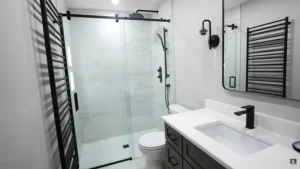
Cost Implications
Deciding between a full bath and a half bath can impact your home’s value and your budget. Understanding the cost implications is crucial. A full bath usually includes a tub, shower, sink, and toilet. A half bath, on the other hand, typically features just a sink and toilet. Let’s break down the expenses associated with each option.
Full Bath Expenses
Installing a full bath can be quite an investment. The costs can vary based on many factors. This includes the size of the bathroom and the quality of materials used. Here’s a breakdown of the typical expenses:
- Plumbing and fixtures: Installing a tub, shower, sink, and toilet can cost between $1,500 to $5,000.
- Tile and flooring: Depending on the quality, expect to spend $1,000 to $3,000.
- Cabinets and countertops: These can range from $500 to $2,000.
- Labor costs: Hiring professionals for installation can add $2,000 to $5,000 to the total cost.
Here is an example cost table:
| Item | Cost Range |
|---|---|
| Plumbing and Fixtures | $1,500 – $5,000 |
| Tile and Flooring | $1,000 – $3,000 |
| Cabinets and Countertops | $500 – $2,000 |
| Labor Costs | $2,000 – $5,000 |
The total cost for a full bath can range from $5,000 to $15,000 or more. This depends on the choices you make. High-end materials and custom work can push the costs even higher.
Half Bath Costs
Adding a half bath is often less expensive. It requires fewer fixtures and less space. Typical costs for a half bath include:
- Plumbing and fixtures: Installing a sink and toilet can cost between $500 to $2,000.
- Tile and flooring: These costs can range from $300 to $1,500.
- Labor costs: Professional installation can add $1,000 to $3,000 to the total cost.
Here is an example cost table:
| Item | Cost Range |
|---|---|
| Plumbing and Fixtures | $500 – $2,000 |
| Tile and Flooring | $300 – $1,500 |
| Labor Costs | $1,000 – $3,000 |
The total cost for a half bath can range from $1,800 to $6,500. This makes it a more budget-friendly option. It’s also quicker to install. Many homeowners choose half baths for smaller spaces or for convenience.
Value In Real Estate
Choosing between a full bath and a half bath can be tricky. Each has its own benefits. Understanding their impact on real estate value is crucial. This helps in making an informed decision.
Impact Of Full Baths
Full baths include a sink, toilet, and shower or bathtub. They add significant value to homes. Here are some key points:
- Increased Home Value: Full baths can boost the resale value.
- Enhanced Comfort: They provide more convenience for families.
- Higher Demand: Buyers often prefer homes with more full baths.
In real estate, full baths are a strong selling point. Homes with multiple full baths often sell faster. They cater to the needs of larger families. This makes them a popular choice in the market.
Let’s look at some statistics:
| Number of Full Baths | Increase in Home Value |
|---|---|
| 1 Full Bath | 5% |
| 2 Full Baths | 10% |
| 3 Full Baths | 15% |
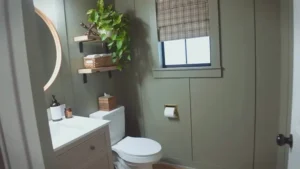
Impact Of Half Baths
Half baths include only a sink and toilet. They are also known as powder rooms. Here are some benefits:
- Cost-Effective: Half baths are cheaper to build and maintain.
- Space-Saving: Ideal for small homes or apartments.
- Guest Convenience: Perfect for guests, avoiding the need to use full baths.
While half baths don’t add as much value as full baths, they still have their advantages. They can make a home more functional. This can be appealing to some buyers. Below are some statistics:
| Number of Half Baths | Increase in Home Value |
|---|---|
| 1 Half Bath | 2% |
| 2 Half Baths | 4% |
| 3 Half Baths | 6% |
In summary, both full and half baths play a role in home value. The choice depends on individual needs and preferences.
Maintenance Needs
When deciding between a full bath and a half bath, it’s important to consider maintenance needs. Both types of bathrooms require regular care, but the extent and type of maintenance can vary significantly. Understanding these differences can help homeowners make informed decisions and keep their bathrooms in top condition.
Caring For Full Baths
Full baths include a bathtub or shower, sink, and toilet. These bathrooms need more maintenance due to their extra fixtures. Regular cleaning is essential to prevent mold and mildew. Soap scum can build up quickly in the shower and tub areas.
- Weekly cleaning of the tub and shower to remove soap scum.
- Monthly deep cleaning to prevent mold and mildew.
- Check for leaks around the tub and shower fixtures.
Water can cause damage if not properly managed. Inspecting the caulking and grout helps prevent water damage. Replacing old caulk can stop leaks before they cause bigger problems. It’s also important to clean the sink and toilet regularly. Using non-abrasive cleaners will keep the fixtures looking new.
Caring For Half Baths
Half baths, also known as powder rooms, contain only a toilet and a sink. These bathrooms are easier to maintain. They do not have a tub or shower, reducing the risk of water damage. Regular cleaning is still necessary to maintain hygiene.
- Weekly cleaning of the sink and toilet.
- Check for leaks around the sink and toilet fixtures.
- Monthly inspection to ensure there are no hidden problems.
Because half baths are smaller, they can be cleaned quickly. Wiping down surfaces regularly will keep them looking fresh. Using a disinfectant can ensure the bathroom stays hygienic. Regular inspections can help identify issues early, making them easier to fix.

Choosing The Right Option
When deciding between a full bath and a half bath, it’s essential to understand the differences and benefits of each. A full bath typically includes a toilet, sink, and a bathtub or shower. A half bath, also known as a powder room, contains only a toilet and a sink. Each option has unique advantages depending on your needs and space availability. This guide will help you choose the right option for your home.
When To Opt For A Full Bath
A full bath is suitable for homes with more space. It offers complete functionality for residents and guests. Here are some reasons to consider a full bath:
- Family Needs: Ideal for families with children. Bathing young kids is easier with a bathtub.
- Guest Convenience: Provides guests with the option to shower or bathe.
- Resale Value: Homes with full baths often have higher resale values.
Full baths are also great in master bedrooms. They offer convenience and privacy. Adding a full bath can significantly improve your home’s comfort and functionality.
When To Opt For A Half Bath
A half bath is perfect for smaller spaces. It’s a practical choice for homes with limited room. Here are some scenarios where a half bath is beneficial:
- Guest Use: Convenient for guests to use without accessing private areas.
- Space Saving: Ideal for small homes or apartments with limited space.
- Cost Effective: Cheaper to install and maintain compared to a full bath.
Half baths are often located near living areas or entryways. They provide quick and easy access for everyone. Adding a half bath can enhance your home’s functionality without taking up much space.
FAQs
Conclusion
Choosing between a full bath and a half bath depends on your needs. A full bath offers complete convenience for families. A half bath provides quick access for guests. Consider your space, budget, and usage. Think about future resale value, too.
Your choice impacts your home’s function and appeal. Make an informed decision for the best outcome. Both options have unique benefits. Evaluate what fits your lifestyle best. Your home should meet your needs perfectly.

